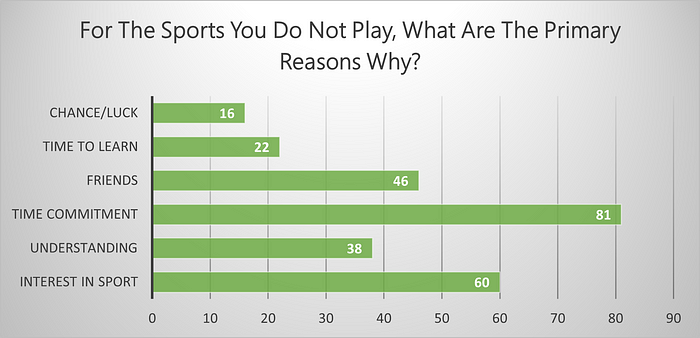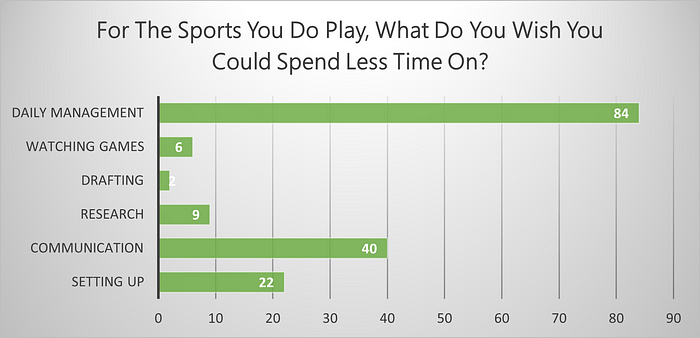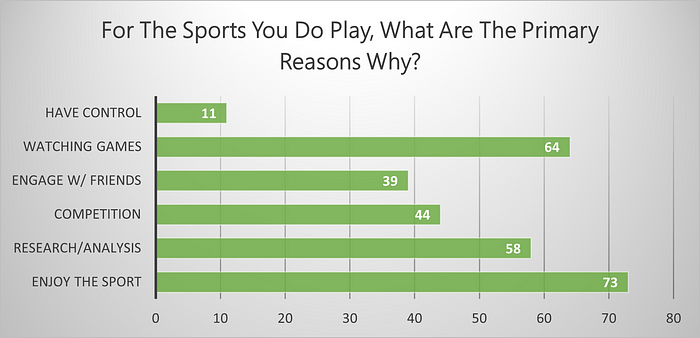
Increasing Engagement In Fantasy Sports
Fantasy Sports is an expansive industry that generates significant revenue and has a massive audience across the country. $1.5 Billion is generated through fantasy football alone according to vinfotech. Despite the massive revenue the fantasy industry already generates, there does seem to be significant room for growth. This is most relevant in sports outside of the NFL, such as the NBA, MLB, and NHL.
According to data presented by YouGov, the NFL has by far the highest percentage of their fans playing in fantasy sports. YouGov reported that 17% of NFL fans participate in fantasy football, which is much more than the other sports. For the other leagues, the NBA is at 11%, MLB is at 8%, and the NHL is at 7% of fans playing fantasy sports. Often, when the difference in people playing is so drastic the initial item to point at is demographics. However, there isn’t anything in the fan makeup of the other leagues that would indicate the NFL should be so much higher. YouGov covers some interesting demographic information as it relates to fantasy sports below:
“There are also some interesting differences by ethnicity. While 15% of the population has played fantasy sports in the past 12 months, this figure increases to 30% of Asian-American, 17% of Hispanic Americans, 18% of Black Americans, but only 12% of white Americans. For all four groups, fantasy NFL (National Football League) is most popular, but Asian-Americans over-index strongly for all fantasy sports.” (Ways for Fantasy Sports Industry to Make Money, n.d.)
When you compare these numbers with the makeup of the demographics of fans in each sport, the Morning Consult reported that the NBA has 46% of its fanbase identify as white, while the other sports are all in between 57% and 60% of their fanbase being white. In context with the numbers above, there is nothing in the available demographics of the league that would show why the NFL has such a significant edge in converting fans to fantasy sports. With the demographics addressed, the answer may lie in the format of the game itself.

To discover this, a survey was conducted on one hundred and fifty active fantasy sports players to determine what caused them to participate in some sports but not others. The demographics of the survey by age broke down as 6 eighteen or younger, 95 between nineteen and twenty-nine, 37 between thirty and thirty-nine, 5 between forty and forty-nine, 3 between fifty and fifty-nine, and 2 sixty or older. The survey was conducted via Reddit and Twitter by Google Forms with results analyzed by Microsoft Excel and SPSS.

Respondents were asked which leagues they had played in previously. 104 said they had played in Fantasy NFL, by far the most. The MLB had 46, the NBA had 44, and the NHL had 30. Soccer leagues were included as well, with 21 in the MLS and 16 having played EPL. It should be noted that the NFL, MLS, and EPL almost universally follow a structure where teams select players at the onset of a season and play one opposing fantasy team week by week with each player only playing one game a week. This is contrasted with the NBA, MLB, and NHL where players have numerous games a week and there is significant variation in how matchups/standings are determined. Most frequently, in the NBA, MLB, and NHL; lineups would be set daily according to which players would be playing on a given day, and standings are determined through the season. In the context of this paper, the NFL, MLS, and EPL will be referred to as one-set leagues, and the NBA, MLB, and NHL will be multi-set leagues.

Respondents were asked for the sports they do not play, what were the primary motivating factors. The leading answer was time commitment, with 54.67% of the respondents marking it. When the responses were filtered to solely those who did not play in the NBA, MLB, or NHL leagues that percentage rose to 74.28% of respondents selecting time commitment as one of the primary reasons. Additionally, 38.57% of respondents said that understanding the fantasy aspects of other leagues was a hesitancy. This intuitively makes sense, as in the one-set leagues there is a much more direct format. This would lead to the conclusion that a significant factor in why many people who play the one-set sports do not also play the multi-set is in relation to the time commitment the multi-set games take up.

Respondents were also asked what their favorite aspects of the fantasy game were. There were eight different response options, with the leading answer being a tie between watching games featuring players on your fantasy team and winning. Each of those answers was marked by 50% of respondents. On the back end, the least common responses were Setting Up The League (3.33%), Coming Up With New Ideas (4.00%), and Choosing Who To Start/Sit (7.73%). When responses were limited to only those in multi-set leagues, only 1 respondent said that Choosing Who To Start/Sit was one of their favorite aspects. This would say perhaps there is room to cut down on time by trimming the start/sit process.

Respondents were also asked what parts of the fantasy sports they do play that they would want to spend less time on. Some participants skipped the question and declined to answer, but for those who did Daily Roster Management was far and away the clear top answer with 84 (56.00%) of respondents marking it. When responses were filtered to solely those in multi-set leagues; 76.19% said Daily Roster Management was something they wanted to spend less time on. This again shows that Daily Roster Management simply takes up too much time when in multi-set leagues.

Respondents were asked what their primary reasons are they play in the fantasy sports leagues they do. Enjoying The Sport (48.67%) and Watching Games Featuring Your Players In It (42.67%) were the most common responses. When filtered to only those in one sport leagues, 73.13% said they played due to enjoying the sport and 47.76% said they played to watch games with players in it. This shows that start/sit decisions are not tied to why people most commonly play fantasy sports, and if anything, removing the start/sit would give owners more players in more games.
In conclusion, it seems that time commitment and specifically start/sit decisions are a significant impediment to more people playing in multi-set fantasy leagues. A recommendation to correct for this is to take from the emerging best ball format, where the optimum lineup is set for the team managers each week. If the multi-set leagues would keep the rest of their settings constant but bring in the feature of setting optimum lineups for participants, it would significantly reduce the barriers to entry for multi-set leagues and make the time commitment significantly reduced. Currently, none of the major sites (Yahoo, ESPN, CBS, and FleaFlicker) offer the option to use Optimum Lineups for private leagues. If the site were to give league commissioners that option in conjunction with appropriate additional features and advertisement; it could be a massive boon for popularity in multi-set leagues.
Appendix
In a personal NFL league this past season, the set up was that optimum lineups would be used to avoid issues with COVID protocol. In order to accomplish this, the commissioner would go in every Monday Night and set the lineups to their optimum prior to the lineups being locked. While this was a laborious process, participants actually enjoyed this alteration to the format as it allowed their entire roster to be eligible any given weekend.
Considering how many people enjoyed the draft process and watching players play in games; it seems most sites should consider expanding the default roster size. This would give team managers a higher chance of having a player in any given game and reduce how much luck was involved in the winner being determined (a frequently cited issue by managers not in NFL leagues).
A curious finding was how reticent participants were in setting up the league and coming up with new ideas about the league. After a few personal discussions with people who had issues with new ideas being introduced, a commonly cited issue was that sites do not do a good job of assisting new managers with adjusting to the new setting. This was especially prevalent in the pre-draft process, where rankings must be edited by the user if settings besides the default are used. Leagues currently do not give commissioners much flexibility at all in the predraft rankings for the league, and if sites were to at the very least allow commissioners to edit predraft rankings for the league to assist in onboarding it would give those wishing to try new settings a significant benefit.
For those looking for fantasy games for unconventional mediums or questions about the process email rmcintyre@fantasizr.com
